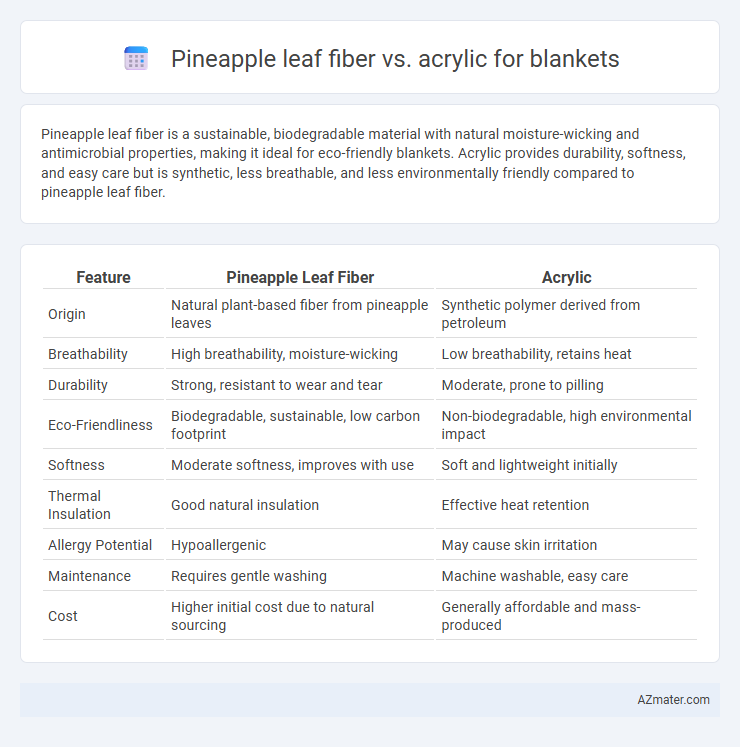Pineapple leaf fiber is a sustainable, biodegradable material with natural moisture-wicking and antimicrobial properties, making it ideal for eco-friendly blankets. Acrylic provides durability, softness, and easy care but is synthetic, less breathable, and less environmentally friendly compared to pineapple leaf fiber.
Table of Comparison
| Feature | Pineapple Leaf Fiber | Acrylic |
|---|---|---|
| Origin | Natural plant-based fiber from pineapple leaves | Synthetic polymer derived from petroleum |
| Breathability | High breathability, moisture-wicking | Low breathability, retains heat |
| Durability | Strong, resistant to wear and tear | Moderate, prone to pilling |
| Eco-Friendliness | Biodegradable, sustainable, low carbon footprint | Non-biodegradable, high environmental impact |
| Softness | Moderate softness, improves with use | Soft and lightweight initially |
| Thermal Insulation | Good natural insulation | Effective heat retention |
| Allergy Potential | Hypoallergenic | May cause skin irritation |
| Maintenance | Requires gentle washing | Machine washable, easy care |
| Cost | Higher initial cost due to natural sourcing | Generally affordable and mass-produced |
Introduction to Pineapple Leaf Fiber and Acrylic
Pineapple leaf fiber is a sustainable natural fiber derived from the leaves of pineapple plants, known for its durability, breathability, and eco-friendly properties, making it an innovative choice for textile applications such as blankets. Acrylic, a synthetic fiber produced from polymer compounds, offers softness, warmth, and resistance to moisture and mildew, commonly used as a cost-effective alternative to wool in blankets. Comparing these materials highlights the environmental benefits of pineapple leaf fiber against the synthetic advantages of acrylic in blanket manufacturing.
Environmental Impact: Pineapple Leaf Fiber vs Acrylic
Pineapple leaf fiber is a sustainable, biodegradable alternative to synthetic fibers like acrylic, offering a significantly lower environmental impact due to its natural origin and reduced energy consumption during production. Acrylic, derived from petrochemicals, contributes to microplastic pollution and emits higher greenhouse gases throughout its lifecycle. Choosing pineapple leaf fiber for blankets supports reduced carbon footprint and minimizes non-biodegradable waste in landfills and oceans.
Production Process and Sustainability
Pineapple leaf fiber, derived from the waste leaves of pineapple plants, undergoes a natural extraction and retting process that minimizes chemical use, making it a highly sustainable raw material for blankets. In contrast, acrylic blankets are produced from synthetic polymers through energy-intensive chemical processes reliant on non-renewable petroleum resources, leading to significant environmental pollution. Pineapple leaf fiber offers biodegradability and lower carbon footprint, whereas acrylic materials contribute to microplastic pollution and slower decomposition rates.
Durability and Longevity in Blankets
Pineapple leaf fiber offers superior durability and natural resistance to wear, making it an eco-friendly choice for blankets that retain strength over time. Acrylic fibers are synthetic, providing good durability and resistance to stretching and shrinking but may degrade faster with repeated washing compared to pineapple leaf fiber. Blankets made from pineapple leaf fiber tend to maintain their structural integrity longer, contributing to enhanced longevity in everyday use.
Comfort and Softness: User Experience
Pineapple leaf fiber offers a natural, breathable texture that enhances comfort by regulating moisture and temperature, making blankets feel cozy without overheating. Acrylic blankets provide a smooth, plush softness that mimics wool, ensuring a warm and cushy user experience ideal for cold climates. Users often prefer pineapple leaf fiber for its eco-friendly softness and hypoallergenic properties, while acrylic is favored for its consistent softness and durability.
Breathability and Moisture Wicking Properties
Pineapple leaf fiber offers superior breathability and moisture-wicking properties compared to acrylic, making it an excellent choice for blankets in warm or humid climates. Its natural cellulose structure allows air to circulate freely, reducing heat retention and promoting dryness by absorbing and releasing moisture efficiently. Acrylic, a synthetic fiber, tends to trap heat and retain moisture, which can lead to discomfort during extended use.
Hypoallergenic Qualities and Skin Sensitivity
Pineapple leaf fiber offers exceptional hypoallergenic qualities, making it ideal for blankets used by individuals with sensitive skin or allergies, as it naturally resists dust mites and mold. Acrylic blankets, while soft and warm, tend to retain static and may cause skin irritation or exacerbate allergies in sensitive users due to synthetic fiber composition. Choosing pineapple leaf fiber enhances comfort by minimizing allergic reactions and promoting better skin health in hypoallergenic bedding.
Care and Maintenance Requirements
Pineapple leaf fiber blankets require gentle hand washing with mild detergent and air drying to preserve their natural strength and texture, avoiding bleach or harsh chemicals that can degrade fibers. Acrylic blankets offer easier care with machine washability and quick drying, but are prone to pilling and may require low heat ironing to maintain appearance. Both materials benefit from storage in cool, dry places away from direct sunlight to prevent damage and prolong blanket lifespan.
Cost Comparison and Market Availability
Pineapple leaf fiber blankets generally cost more due to the labor-intensive extraction process and limited production scale, whereas acrylic blankets are more affordable owing to mass production and synthetic manufacturing efficiency. Market availability of acrylic blankets is significantly broader, with widespread distribution in retail and online stores, while pineapple leaf fiber blankets remain niche and primarily found through specialty eco-friendly vendors. Consumer demand for sustainable textiles is gradually increasing pineapple leaf fiber market presence, but acrylic dominates due to cost-effectiveness and easier accessibility.
Conclusion: Which Fiber is Best for Blankets?
Pineapple leaf fiber offers superior sustainability, breathability, and natural antibacterial properties compared to acrylic, making it an eco-friendly choice for blankets. Acrylic blankets excel in affordability, softness, and ease of care, but lack the biodegradability and moisture-wicking benefits of pineapple leaf fiber. For those prioritizing environmental impact and durability, pineapple leaf fiber is the best option, while acrylic suits budget-conscious consumers seeking low-maintenance warmth.

Infographic: Pineapple leaf fiber vs Acrylic for Blanket
 azmater.com
azmater.com